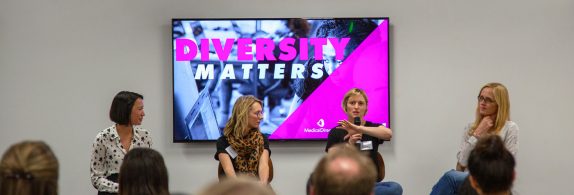The future of women in technology
At an undergraduate level, the representation of women in science, technology, engineering and maths (STEM) is 50/50, yet women make up of only 16% of STEM graduates and 27% of the STEM workforce. So how can we support the next generation of women in technology?
In a recent panel hosted by HotWire at MedicalDirector’s offices, a panel of female executive leaders explains it all starts with tackling a very real ‘unconscious bias’ that women face in the hiring, managing, promotion and salary negotiation process.
Seeking a supportive environment
Petra Gross, MedicalDirector’s Chief Product Officer, recalled her experiences managed by both men and women, and the challenges she faced to find a supportive working environment.
“I worked in Silicon Valley for fifteen years, starting at eBay for 8 years, and then in a variety of startups, and I’ve been back for four years now in Sydney,” she said. “That was when eBay was only two years’ old, and the concept of online auctions and trading with people you didn’t know was very mind-blowing.”
According to Gross, working in a tech environment was very exciting, and at the time eBay was generally very supportive towards women in technology – until she had her first child.
“I reported into a female who was wonderful and really supportive,” she explained. “In the US, the maternity laws are just terrible – you’re considered to be incredibly lucky if you can take four months off. But I worked with a woman who was so supportive, she said I could come back two or three days if I wanted, and reassured me that ‘we’re here for you’.
“But I really underestimated what that meant, until I no longer worked with that manager.”
Once there was a shift in management, Petra recalled things were completely the opposite, and she was told to return to work five days a week, with no explanation as to why.
“That was when I started to really see the difference in terms of how women were treated – based on the manager they had,” she said. “At that time, I was a lot younger, but I quickly realised that where I wanted to work, and who I wanted to work with – needed to be very supportive. They needed to be my champion.”
After leaving eBay, Gross began working in the start up world, where she said she became used to working in a male-dominated, ‘locker room’ environment, until she realised she couldn’t do it anymore. She then decided to work for companies that were founded by women.
“That proved to be a really great experience for me,” she said. “But interestingly when I moved back to Sydney, I ended up working in an environment where I was working for a female CEO who was incredibly unsupportive.”
So even though we tend to try to look for patterns in life, and through experience may think male managers are different to female managers, Gross highlights that we shouldn’t fall into the trap of stereotyping.
“I wished I had the opportunity to attend these panels back then, where I could really gain the experience of listening to people who had so much more learnings from their career growth that I had at the time,” she added. “Would I prefer to work with a male or female manager? At the end of the day, it’s all about how they behave, how they lead and how they support you.
“You want to work with supportive people so that you do your best work everyday. That’s the key – to surround yourself to work with people who are genuinely and proactively supportive.”
Tackling ‘unconscious bias’
Diverse teams are 20% more innovative and mitigate risks 30% more effectively, according to research by Deloitte. However when it comes to women in technology, only 28% of tech jobs are held by women.
At the same time, there’s also still along way to go for more gender diversity at board level. In fact, female CEOs won’t achieve equal representation until 2100, according to a new report by Bankwest. Further, female chief executive roles have only risen a meagre 1.1 per cent since 2014 and 4.4 per cent for senior female managers.
“Most people associate leadership qualities with men – because men are always seen as the ones in charge,” Gross said. “Men are traditionally seen as assertive, rational, objective. Women are traditionally seen as caring, warm, encouraging and supportive. So these stereotypes always surface when considerations are being made for leadership roles.”
Sheryl Sandberg’s international best selling book, Lean In, describes how a resume of a very accomplished female candidate ‘Heidi’ was given to a set of students at a business school, and her name was changed to ‘Howard’ and given to another set of students for review. The results were remarkable.
Students who read Howard’s resume judged him as likeable and a good colleague, while Heidi was labelled as aggressive, selfish and not a team player.
“This experiment demonstrates this inherent bias we have based on gender, even though both are equally competent,” Gross said. “So when we hire for talent in technology, let’s remove the photos and remove the names. Let’s look purely at experience – and see whether that changes your thinking. It’s time to take action and challenge our own unconscious bias, so that we can help instigate change.”
Dr Carla Harris, CEO & Co-founder at Longevity App and Director at FinTech Australia, highlighted how the bias also surfaces during promotion and pay negotiation phase.
“Men are very comfortable at asking for a pay rise, but women often feel penalised and judged,” she said. “So while negotiation training and inspiring women to be more assertive during the promotion phase is important, we need to be mindful of the dangers of the ‘backlash effect’ that is still prevalent in many working environments.”
Emma Pudney, Rackspaces’ ANZ Director of Architecture, Onboarding and Professional Services, stressed that the unconscious bias is apparent as early as graduate level.
“When we needed to hire an engineer, we came across a study from the Australian Government that revealed men in technology received $5,000 more annually than women straight out of university,” she said. “Now that’s shocking. You’re as clean a slate as you can be – yet you still see a significant difference in pay.”
Pudney explained how Rackspace is rolling out an exciting initiative where the company is working on a new women in technology leadership initiative, with major cloud partners such as Amazon and Microsoft Azure, to target 30 women in IT and provide them with associate level certification.
“It’s about offering training, education and extensive mentorship, with the goal being to have 30 or more women in that funnel,” she said. “It’s about being more aware of the need to make a change. And even if it’s just 30 women in Australia, it’s a great start to potentially rolling the initiative out internationally to the US and UK if it proves successful.”









